Short Book Reviews
Hanna Kryszewska, Poland
Hanna Kryszewska is a teacher, teacher trainer, trainer of trainers. She is a senior lecturer at the University of Gdańsk, and EU Teacher Training College where she trains pre-service teachers. She is co-author of resource books: Learner Based Teaching, OUP, Towards Teaching, Heinemann, The Standby Book, CUP, Language Activities for Teenagers, CUP, The Company Words Keep, DELTA Publishing, and a course book series for secondary schools: ForMat, Macmillan. She is also co-author of a video based teacher training course: Observing English Lessons. Hania is a Pilgrims trainer and editor of HLT Magazine.
E-mail: hania.kryszewska@pilgrims.co.uk

Macmillan English Quest 3 and 4 . Pupil’s Book. J. Corbett, R. O’Farrell, Macmillan. (this edition 2013) ISBN 978-0-230-45664-8, pp.64 and ISBN 978-0-230-45673-0, pp.64, respectively. The first part of this course was reviewed in the October 2012 issue of HLT. Initially the course was described as a ‘new two level English course’. Clearly the course must be a success as the authors and publishers have decided to write and publish level 3 and level 4. The two new parts are aimed at children at primary level who have been learning English for some time and who can read and write on paragraph level. Literacy skills are practiced among others through phonics and reading combined with listening. The main theme of the books is maintained i.e. following the in-house characters who are children who experience fantastic adventures thanks to an amazing computer game. They go to different places, learn about people and cultures. Some educational bodies and parents may not like the glorification of a computer game which controls the children’s experiences or the fact the children meet a lot of dragons, dwarfs and talking animals. Also this formula continued on level 3 and 4 may become a bit boring and too repetitious for the young learners. However the fictional and magical world is balanced with factual and informative content e.g. different alphabets people use, Australian animals, different currencies, different jobs etc. Unfortunately a lot of the illustrations are in the same style as in part 1, i.e. reminiscent of cheap seventies and early eighties cartoons loved by some publishing houses or editors. The full package contains a student’s book, an activity book, an animated stories and songs CD_ROM, a teacher’s book, class audio CDs, flashcards and a digibook.
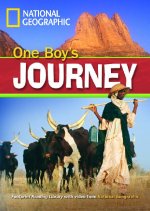
Footprint Reading Library. series editor Rob Waring, HEINLE CENGAGE Learning (2008). e.g. One Boy’s Journey ISBN-13: 978-1-4240-1080, pp 24. The National Geographic Footprint Reading library is series a multilevel factual readers which is well established on the market. The series contains over one hundred readers which come with an audio recording of the given reader and a video which is an adaptation of National Geographic films for learners of English. The series encourages and helps learners to improve their reading skills, especially extensive reading through engaging non-fiction content. The language content is combined with content derived from other subjects, especially culture, geography and history, which makes the series a CLIL publication. (Content and Language Integrated Learning)
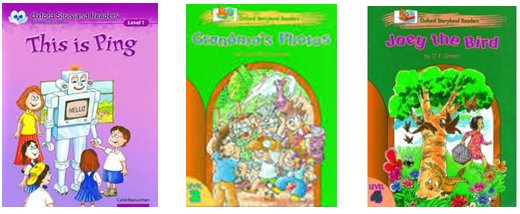
Oxford Storyland Readers. Level 1-12. Different authors, e.g. D. F. Green, C. MacLennan, . Oxford. (first published 1994). e.g. This is Ping ISBN 0-19-586129-9, pp16 Grandma’s Photos, ISBN 0-19-586135-3, pp.16, Joey the Bird ISBN 0-19-586144-2, pp20. This twelve level series of readers is well established, yet worth a mention in these reviews. It is intended for young learners 8/9+ depending on their literacy level and fluency in reading. Each of the 48 books contains a cartoon story told in graded down language suitable for the given language level. The story is told in sections interspersed with language activities, puzzles, crossword puzzles and picture dictionaries, which aim at reinforcing the new language and further develop the learners’ reading skills. At the end of each reader there are some comprehension questions which check how well the learners have understood the text and how much they remember . Additionally readers at levels 7-12 contain related factual sections. The 9 titles I have had a chance to look at include: This is Ping, Grandma’s Photos, and Joey the Bird. The level 1 stories are very basic revolving around a few lexical sets and very restricted grammar. But as the level goes up the stories become more entertaining e.g. Joey the Bird. The books are visually pleasing and varied as they have been illustrated by a number of illustrators. These are very good publications for the ‘reading corner’ or the ‘self-access centre’.
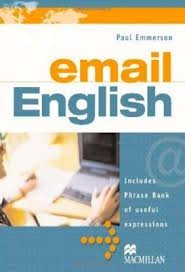
email English. 2nd Edition. P. Emmerson. Macmillan (this edition 2013). ISBN 978-0-230-44855-1. The book is an updated edition of the best selling book first published in 2004. The ‘old chapters’ dealing with basic information, language focus and language accuracy, style and writing genres have been enriched by new sections which refer to using new social media.
I cannot judge how much the exercises have changed but I can see that there is also a ‘phrase bank of useful expressions’. The book starts with a letter to the student and a letter to the teacher, which looks at the book from the perspective of the learner and the tutor. The book has a very informative key at the end which means the book can be used for self-study as well as with the whole class.
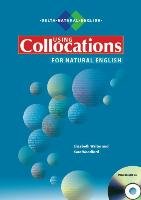
Using Collocations for Natural English. E. Walter and K. Woodford. (2010) DELTA Publishing. ISBN 978-1-905085-52-1, pp 128. This book has been published in the DELTA Natural English series by two authors who have also written Using Phrasal Verbs for Natural English (which was reviewed in HLT in Aug 2012) The book looks at the ways we teach vocabulary or lexis. Many teachers and learners tend to focus on individual lexical items or words, and neglect collocations and bigger chunks of language. This is bad learner training which does nor guarantee quick success in the way learner’s communicate in a natural and native-speaker-like way. Collocations in this book are presented in natural and memorable contexts grouped around a theme, e.g. importance, success, people’s appearance, relationship, personality etc. which help to memorise and then use the chunks actively. First collocations are reviewed and presented in a variety of ways, and then learners get ample practice which is usually fun and not mechanical. There is a lot of emphasis on using collocations appropriately with recognition of suitable contexts and registers. The units I like best are: collocations in speaking and collocations for feelings. The book is aimed at B1-B2 levels according to CEFR, but I am sure teachers can become inspired and adapt some of the ideas or activities for lower or higher levels. The book comes complete with a CD. The book is highly recommended as a supplementary material for ELT classes.
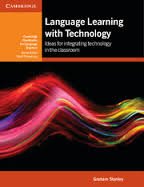
Language Learning with Technology. Ideas for integrating technology in the classroom. G. Stanley. Cambridge. ( 2013). ISBN 978-1-107-62880-9, pp 250. The book was published in the well established series: Cambridge Handbooks for Language Teachers. It is an ideal resource for trainers who work with in-service and pre-service teachers. Using modern technology is becoming or perhaps has already become a must in many educational environments, either because learners expect it or because educational authorities impose it on teachers. So a well structured and state-of-the-art pre-service teacher training course needs to take on board the issues of using technology in class. Many in-service teachers who realise that they need to start using technology or would like to use technology on a more regular basis, want to attend courses where they can learn more. This book is a fantastic collection of language activities which combine technology with usual focus areas of our teaching such as: vocabulary, grammar, listening, reading, writing, speaking, pronunciation, project work, and assessment and evaluation. Personally I particularly like the first two chapters which deal with introduction to integrating technology in our teaching and building a learning community, Appendix A - learning technologies guide, and Appendix B – technical notes and suggested software/ websites by chapter. The book can also be used for self-study by teachers who want to develop themselves by working through the book and trying the ideas. Highly recommended.
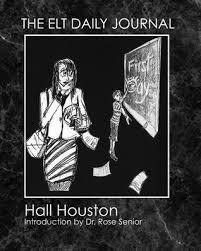
The ELT Daily Journal. H. Houston. Introduction by Dr. Rose Senior. ( 2013) Anthimeria Press. ISBN 978-1481957397, pp136. This book is what the title says and promises: it is mainly a journal with blank pages to be filled in by the teacher, the owner of the journal. Yet it is a structured journal as at the bottom of each page there is a teaching idea which the teacher is to try out, reflect on in writing and add perhaps some more ideas. The subject areas include: warmers and closers, icebreakers, classic activities etc., however the range is fairly limited and I would have liked to see more variety in the areas the teacher is to reflect on. At the end of the book there are tips for teaching coming from fifteen people who are described as ELT VIP’s or legendary ELT authors… Since my name is among them I would more modestly call them people well known in the field. But joking apart, the tips are very interesting and approach teaching language from very different angles. I am sure the book will make a very good present for someone who is planning to take a teaching certificate course such as CELTA, TKT or TESOL.
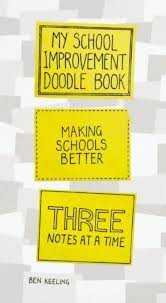
My school improvement doodle book. Making schools better. Three notes at a time. B. Keeling (2013) Independent Thinking Press ISBN 978-178135051-5, pp 60.
This is a very original book by a graphic designer who drifted and became a teacher and leadership team member. Basically the book consists of 50 pages with 3 drawings per page, which look like three post-it notes (see the cover). Each page has a title, e.g. targets, rev down or potential. Take a look for yourself at the three drawings for the latter:
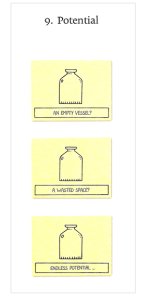
All the pictures are drawn with the great simplicity and elegance, while the captions are brief and succinct. In this way the message becomes intriguing and thought-provoking, and often ironic. As the title suggests, the topics refer to school life, and aim at making the school a better place through our reflection.

Please check the Methodology and Language for Primary Teachers course at Pilgrims website.
Please check the Methodology and Language for Secondary Teachers course at Pilgrims website.
Please check the Teaching Advanced Students course at Pilgrims website.
Please check the English for Teachers course at Pilgrims website.
Please check the ICT - Using Technology in the Classroom – Level 1 course at Pilgrims website.
Please check the ICT - Using Technology in the Classroom – Level 2 course at Pilgrims website.
Please check the Certificate in Teaching Business English Level 1 course at Pilgrims website.
Please check the How to be a Teacher Trainer course at Pilgrims website.


|